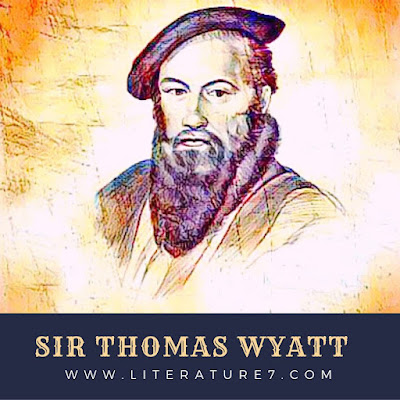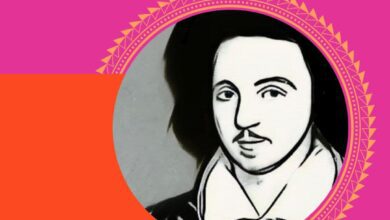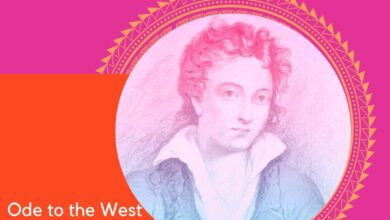Discuss the evolution of english poetry from Sir Thomas Wyatt to Edmund Spenser | English Poetry

In the fifteenth century, England was poetically barren. With the advent of a new era, the Elizabethan era, a glimmer of hope shone through the poetically bare ground. The first settlers were Sir Thomas Wyatt (1503–1542) and Henry Howard, Earl of Surrey (1517–47). They rekindled the waning interest in poetry in England by adding the sonnet and the lyric. They paved the way for Sidney’s, Spenser’s, and Shakespeare’s subsequent development, and their contribution is deserving of consideration.
Sir Thomas Wyatt (1503-42)
Thomas Wyatt was educated at Cambridge and was tasked with several important diplomatic missions upon joining the King’s service. He traveled through Italy, Spain, and France. When he returned to England, he wished to model English verse after the Italians or the ancient Greeks as seen through the eyes of the Italians. His first objective was to reintroduce nobility and grace to English poetry, which had been lost during the fifteenth century.
Wyatt was the first poet to incorporate the sonnet into English poetry, following Petrarch’s model. The sonnet reintroduced lyricism into English poetry. It paved the way for Sidney and Spenser to cultivate music and passion.
Read more Chaucer’s portrayal of ecclesiastical characters in the prologue to the canterbury tales
Wyatt’s poems were brief but plentiful. They were primarily translations and imitations of Italian poetry, especially the love sonnet and more severe and didactic Latin poetry, such as satires and epistles. Wyatt’s love sonnets, totaling ninety-six, were published posthumously in Tottle’s Miscellany in 1557. Wyatt’s love sonnets laid the groundwork for Sidney and Spenser’s love sonnets. They glowed with the fire of affection, and it is to Wyatt’s credit that he imbued English poetry with emotion and passion, fervor and enthusiasm. For the first time, we hear the poet’s heart’s fervent voice in these sonnets. This poet pioneered the use of personal notation in poetry.
Wyatt was a poet of the purest, most serene ray. He wrote epigrams, poems, and rondeaux, which were slightly superior to his sonnets. They demonstrate Wyatt’s delicacy and sophistication, which were characteristic of the new romanticism. His Satires were written in the Italian terza rima style, indicating the direction of emerging trends.
Read also What is the impact of the Renaissance on Doctor Faustus
Wyatt’s primary instrument was the sonnet, a genre he pioneered in English literature. The sonnet is the most difficult way in which to be vague, turgid, and irregular. There is no better remedy for imprecise thinking, loose language, and irregular metre, and Wyatt’s benefaction to English poetry begins and ends with the invention of the sonnet. His thought model, and up to a point, his type model, was Petrarch’s sonnet, of whom he was a close student.
Henry Howard, the Earl of Surrey (1517-47)
The Earl of Surrey’s work consists of sonnets and other poems in various metres, all of which are noteworthy for their grace and finish. He shared with Wyatt the credit for introducing the sonnet to England from Italy. He abandoned the Petrarchan model popularised by Wyatt in favor of the Shakespearean sonnet, which consists of three quatrains followed by a couplet.
Surrey lacked Wyatt’s vitality, but he was a more gifted artist. His sonnets were written to Geraldine or Lady Elizabeth Fitzgerald and were rooted in passion. They were described by emotional flights of fancy underscored by a mournful tone. When we compare them side by side, we find a true respect for nature that we first encountered in Chaucer’s poetry. In his personal sonnets, he mixed love and nature and imbued them with his personality. Surrey also wrote impersonal sonnets with ironic references to contemporary figures. The ‘Sonnet to Sardanapalus’ is an apolitical piece. It is written in a sarcastic tone. It is remarkable for its absolute worth, its dignified swing, and its attempts at thinking compression.
See more What are the chief characteristics of Milton’s Grand Style
Surrey is credited with being the first English poet to use blank verse in his translation of the Aeneid’s two plays. Surrey did not invent the blank verse; it had been used in Italy a few years before in a translation of the same work, but the happy talent with which he embraced it, and thus discovered English poetry’s most strong and characteristic verse form, is deserving of all praise. Legouis observes, in response to Surrey’s blank verse, “Surrey’s blank verse is simply the unrhymed decasyllabic or heroic line. It is scholarly, not popular; Surrey understood that his line should not be too loosely rhymed and that he should emulate Virgil’s breaks and extension of meaning from line to line.
However, he did so infrequently and without the ease and trust gained by his imitators decades later. Wyatt was stripped of the epic tone, and his metre, such as it is, proved to be more capable of rendering the Latin hexameters than the couplet. Surrey endowed English prosody with a magnificent instrument that was to serve as the metre for both dramas and epics “Tottle’s Collected Works
Tottle’s Miscellany was published in 1557, marking modern English poetry in the public domain. It included poems by Wyatt, Surrey, and some of their contemporaries. It contains approximately 300 lyrics, songs, and sonnets. This Miscellany contains early Elizabethan poetry.
Thomas Sackville (1536-1608)
Sackville’s poetry does not amount to much in terms of volume, but it is important in terms of merit. He is the author of The Mirror of Magistrates and Induction, both of which are considered seminal works. “Both are written in the rhyme royal stanza, are melancholic and elegiac in spirit, and use archaic vocabulary, but possess a severe nobility of thinking and a grandeur of conception and language unmatched since Chaucer’s time.”
See also Plot Construction of Dr. Faustus
His Mirror of Magistrates paints a vivid image of the underworld, as the poet discusses his encounters with prominent Englishmen who had met with misfortune. While not entirely written by Sackville, his hand is clearly visible in the Prologue, where we encounter a Dantesque strength and force of allegorizing unmatched in Elizabethan poetry except in the pages of Spenser. This work demonstrates his uniqueness, and it is for this reason, he is known as the most innovative literary force between Chaucer and Spenser.
Induction is more potent than The Magistrates’ Mirror. It is written in seven-line stanzas (ababbcc), a form that Chaucer mastered. The poet transports the reader to Hell in this work, where he encounters great fallen princes and nobles who recount their tales of misery and suffering in a pathetic, sorrowful, and sombre tone.
The Middle Ages had not conceived vision so tense and implacably sinister since Dante’s Inferno. Spenser was influenced by Induction when he painted the most gloomy scenes in The Faerie Queene, such as the Cave of Despair, and even more so when he wrote the melancholy stanzas of his Complaints, especially the Ruins of Time and Tear of the Muses. Sackville is truly deserving of the moniker “connector” between Chaucer and Spenser.
Related Spenser is at once a child of the Renaissance and the Reformation. Discuss
Sackville made a significant contribution to the development of versification and the metrical side of poetry. He was more consistent than both Wyatt and Surrey in re-establishing alternate accents. He pounded out his syllables with unmistakable force. He had a sure touch and a lack of technical mistakes that distinguished him from Wyatt and Surrey, and his inventive vitality was reminiscent of the great poets who would follow.
George Gascoigne (1537-77)
Gascoigne introduced the first English comedy, The Supposes (from Ariosto); the first daily verse satire, The Steel Glass; the first prose tale from Bandello; and the first translation from the Greek tragedy Jocasta. Against this imitation product, his original verse, especially the Lullaby of a Lover, which possesses all the lyrical and spiritual qualities of Elizabethan song, must be set. He was a competent metrical artist with a flair for imagination, as shown by his Flowers, Herbs, and Weeds. His blank verse was accurate but uninteresting.
Related Chaucer’s contribution to the growth and development of the English language
It sounded like a hammer slamming into a wooden anvil. It is indicative of his technical ability that he wrote a brief treatise on versification, a manual for other authors, entitled Some Notes or Instructions Concerning the Making of Verse or Rhyme in English.
Sir Phillip Sidney (1554-86)
Sidney was the leader of an elegant coterie and wielded near-absolute power throughout his life. Before Spenser and Shakespeare, he was the most commanding literary figure. Like the best Elizabethans, Sidney was famous in many fields of literature, but his works were not published until after his death. Astrophel and Stella, a compilation of 108 sonnets and eleven songs, was his magnum opus of poetry. This thesis was completed in 1591. It is a series of songs and sonnets addressed to Lady Penelope Devereux, later Lady Rich.
Sidney and Lady Penelope had ended their relationship, and Lady Penelope married Lord Rich, with whom she spent a brief period of an unhappy marriage. Suppose Sidney loved her too late or wrote love sonnets, as much of the traditional material in the Italian of a man who loves too late does. In that case, one hesitates to attribute them to simple dramatic abilities. Petrarch and Ronsard strongly influence these sonnets, tone, and style, establish Sidney as the greatest Elizabethan sonneteer aside from Shakespeare. They show genuine lyric emotion couched in a delicately archaic script. Between Wyatt and Spenser, Sidney is unquestionably the greatest literary figure.





